
ITEM: WH-AZ035-M1
WH-AZ006-M1
ANZZI ELECTRIC INSTANT WATER HEATER
INSTALL & OPERATION MANUAL
V1.0
next page


PRODUCT SIZE CHART
TOOLS AND MATERIALS
Thank you for purchasing ENVO ELECTRIC INSTANT WATER HEATER. To enjoy
your hot water life at its best, please read and follow the installation and operation
instructions carefully, to ensure the long life and reliable operation of this
appliance. FAILURE TO DO SO COULD CAUSE PROPERTY DAMAGE, SERIOUS
INJURY, OR DEATH. Please keep this manual for future reference.
Bucket

TABLE OF CONTENTS
Safety Precautions -----------------------------------------------------------------------------
Electrical Diagram ------------------------------------------------------------------------------
Product Inner Structure ----------------------------------------------------------------------
Product Specifications -----------------------------------------------------------------------
Installation Guideline -------------------------------------------------------------------------
Installation ----------------------------------------------------------------------------------------
Operation Instructions ------------------------------------------------------------------------
Cleaning & Maintenance ---------------------------------------------------------------------
Trouble-Shooting -------------------------------------------------------------------------------
Packing List --------------------------------------------------------------------------------------
PG.1
PG.3
PG.3
PG.4
PG.4
PG.6
PG.10
PG.10
PG.11
PG.11

WARNING
Use stainless steel flexible hoses or copper
tubes of 1/2” on the inlet and outlet.
DO NOT USE PVC, CPVC or plastic supply
line directly to the heater.
This appliance is forbidden to be switched
on if you think it may be frozen, as this could
result in serious damage to the unit. Wait until
you are sure that it has completely thawed out
before you switch it on.
This appliance is not intended for use by
persons (include children) with reduced physical
sensory or mental capabilities, or lack of
experience and knowledge, unless under careful
supervision. Children should be supervised to
ensure that they do not play with the appliance.
Safety and energy conservation are factors to
be considered when selecting the water
temperature setting of water heater’s thermostat.
Water temperatures above the 125°F (52°C) can
cause severe burns from scalding.
DO NOT store or use gasoline or other
flammable vapors and liquids in the vicinity of
this or any other appliance. Keep rags and other
combustibles away.
If the water heater has been subjected to flood,
fire, or physical damage, turn off power and water
to the water heater. Do not operate the water
heater again until it has been thoroughly checked
by qualified service personnel.
When using electrical appliances, basic
safety precautions should always be
followed including the following:
The installation must be in compliance with
the National Electrical Code, your local
electrical and plumbing codes.
This appliance must be GROUNDED.
CONNECTED ONLY TO A CIRCUIT THAT IS
PROTECTED BY A RECOGNIZED GROUND-
FAULT CIRCUIT INTERRUPTER(GFCI).
We highly recommend that you employ the
services of a professional to assist you with
this installation if you are not familiar with
basic plumbing and electricity. Under no
circumstances should you attempt to install,
repair or disassemble the water heater
without first disconnecting the electricity.
Install or locate this water heater only in
accordance with the provided installation
instructions.
Use this water heater only for its intended
use as described in this manual.
This appliance MUST be permanently
connected to the fixed circuit breaker and it
must be installed vertically. DO NOT install
near tinder or a strong magnetic field.
SWITCH OFF the breaker before removing
the cover for servicing.
If there is damage to the wire, you must
contact qualified electrician to replace it with
dedicated wire from our authorized dealers.
PG.1
SAFETY PRECAUTIONS

CAUTION
FOR HOUSEHOLD AND INDOOR USE ONLY.
SAVE THIS INSTRUCTION
ATTENTION
Increasing the water temperature setting
may improve the cleaning performance of
dishwashers.
The user can adjust the temperature setting
to meet their needs. Always read and
understand the safety instructions contained in
the manual before adjusting the temperature
setting.
If the water heater is to remain idle for an
extended period of time, the power and water
to the appliance should be turned off and the
water heater drained to conserve energy and
prevent a buildup of dangerous hydrogen gas.
This unit has no power button, power can only
be shut off at the circuit breaker or disconnect
switch. The water heater and piping should be
drained if they might be subjected to freezing
temperatures. After a long shutdown period, the
water heater’s operation and controls should be
checked by qualified service personnel. Make
certain that water is flowing to water heater
again before placing it in operation.
Statement: ENVO does not assume any
responsibility for the losses caused by the
improper installation and behavior listed
above or other improper operations.
It is extremely important to FLUSH the
pipes to wash away sundries and residue in
the pipes before connecting the water heater
to it.
Risk of Fire - Hydrogen gas can be produced
in a hot water system served by this water
heater that has not been used for a long period
of time(generally two weeks or more).
HYDROGEN GAS IS EXTREMELY FLAMMABLE!!
To dissipate such gas and to reduce risk of
injury, it is recommended that the hot water
faucet be opened for several minutes at the
kitchen sink before using any electrical
appliance connected to the hot water system.
If hydrogen is present, there will be an unusual
sound such as air escaping through the pipe
as the water begins to flow. Do not smoke or
use an open flame near the faucet at the time
it is open.
Safety regulations require a factory setting no
greater than 125°F (52°C) for all new water
heaters. Therefore, if your old water heater was
set to a hotter temperature than your new water
heater with a factory setting of 120°F (49°C), the
new water heater may seem to provide lower
capacity than your old water heater. This can be
corrected by increasing the temperature setting.
SAFETY PRECAUTIONS
PG.2

Fig 1
PG.3
WH-AZ035-M1
ELECTRICAL DIAGRAM
PRODUCT INNER STRUCTURE
32
32 32
32
32
E
E
E
E
E
E
WH-AZ006-M1

Note: For supply connections, confirm using correct breaker size and wire gauge.
Connected only to a circuit that is protected by recognized ground-fault circuit
interrupter (GFCI).
Make sure the appliance is intact, and the
fittings are complete.
Please make sure the main power supply,
water pressure, grounding condition,
ammeter and wire reach the standard of
installation requirement.
Clean all the impurities of the pipe by
allowing water to flow for a few minutes
before connecting the heater to the supply
line. Any residue or dirt in the pipes may
cause damage to the heater.
We strongly recommend installing a water
filter before the inlet of heater. Hard water or
water with high levels of minerals and alkali
can cause damage to this unit. Water
softening system is needed for this case.
Voltage 120V 240V
Wattage 3500W 6000W
Rated Current 29.5A 25A
Min. required circuit breaker 32A 32A
Min. wire size (L,N,L1,L2,E) 10 AWG 12 AWG
Max. water pressure 87 Psi (0.6 MPa)
Min. water flow to activate unit 0.4 GPM (1.5 L/min)
Weight 4.21 lbs
Product Dimensions (D×H×W) 3.86” x 6.3” x 7.8”
Water connections 1/2’’NPT
Model WH-AZ035-M1 WH-AZ006-M1
It must be fitted with a pressure reducing
valve adjacent to the entrance when the inlet
pressure is higher than 150 Psi (1034kPa).
DO NOT install near tinder or a strong
magnetic field. The appliance can be installed
above or under the sink, and unit must only be
mounted with inlet & outlet pointing downward
or upward VERTICALLY near by the water
fittings.
It is recommended to install the appliance no
more than 4 ft from the point of use to save
power.
Avoid locations that are prone to dampness,
high humidity, moisture, or dust.
PG.4
PRODUCT SPECIFICATIONS
INSTALLATION GUIDELINE

Install the water heater in a dry, clean area,
as close to the target faucet as practically
possible. Avoid installing in rooms that are
subject to freezing temperatures or corrosive
atmosphere. Long uninsulated hot water
lines can waste energy and water.
NOTE: Make sure the water heater and hot
water outlet pipe are out of the reach of
children to avoid tampering with the controls
or burn themselves on hot water outlet pipe.
Moving the water heater or other appliances
to provide service to the water heater is not
covered under warranty.
If a check valve is present on the inlet
water line, it will create a “closed system.”
Heating water in a closed system creates
an increase in pressure within the water
system because the pressure is not able to
dissipate in the main supply line. Referred to
as “thermal expansion”, the rapid pressure
increase can cause the relief valve to operate
(releasing water) during each heating cycle,
potentially causing premature failure to the
valve or even the water heater. The
suggested method of controlling thermal
expansion is to install an expansion tank in
the cold water line between the water heater
and the check valve. Contact your installing
contractor, water supplier, or plumbing
inspector for additional information.
Before installing this product, make sure the
installation location has sufficient electrical
power available to handle the maximum
amperage load for the water heater.
Proper ground connection is essential. The
presence of water in the piping and water
heater does not provide sufficient conduction
for a ground. Nonmetallic piping, dielectric
unions, flexible connectors, etc., can cause the
water heater to be electrically isolated. Do not
disconnect factory ground.
It is recommended for this product to be
installed by a licensed and qualified
electrician in accordance with all applicable
national, state, and local electrical codes.
Under no circumstances should you
attempt to install, repair, or disassemble the
water heater without first shutting off power
directly at the fuse or breaker.
There must be sufficient clearance between
any object and the top, rear and sides of the
water heater in the event service is needed.
The controls and plumbing connections at front
of unit must have clear access for operation and
service.
Recommended Minimum Clearances:
12” above and below the water heater
6” in front and to both side of the water heater.
A separate branch circuit with copper
conductors, overcurrent protective device and
suitable disconnecting means must be provided
by a qualified electrician.
All wiring must conform to local codes or latest
edition of National Electrical Code ANSI/NFPA
70.The voltage requirements and wattage load
for the water heater are specified on the rating
label on the front of the water heater.
The branch circuit wiring should include either:
1. Metallic conduit or metallic sheathed cable
approved for use as a grounding conductor and
installed with fittings approved for the purpose.
2. Nonmetallic sheathed cable, metallic conduit
or metallic sheathed cable not approved for use
as a ground conductor shall include a separate
conductor for grounding. It should be attached to
the ground terminals of the water heater and the
electrical distribution box.
PG.5
WARNING
INSTALLATION GUIDELINE

General
The ENVO electric instant water heater can be used to heat bathroom sink
faucets, kitchen sink faucets.
Mounting the unit
Front and back on unit illustrated below (fig 2).
Fig 2
ENVO does not cover any damage or defect caused by installation, attachment
or use of any type of energy-saving or other unapproved devices (other than those
authorized by ENVO) into, onto or in conjunction with the water heater. The use of
unauthorized energy-saving devices may shorten the life of the water heater and
may endanger life and property.
ENVO disclaims any responsibility for such loss or injury resulting from the use of
such unauthorized devices.
NOTE: do not cover the operating or warning labels attached to the water heater
or attempt to relocate them.
PG.6
ATTENTION
INSTALLATION GUIDELINE
INSTALLATION

Step 1:
1. Mark two screw hole locations on the wall where the water heater is going to be placed.
Make sure both holes are vertical and 5.75” (146mm) apart if installing the heater with the
outlet and inlet pointed downward or 5.47” (139mm) if the outlet and inlet pointed upwards.
2. If screw locations are in wall stud, drive mounting screws directly into stud. if screw
locations are not in stud. Drilling two 0.24’’(6mm) diameter holes on the wall. Insert the
plastic anchors into the holes and then drive screws into wall anchor.
Step 2:
Heater with the outlet and inlet pointed
downward:
1. Place water heater on wall and slide
onto mounting slot.
2. Secure water heater to wall with screw
through safety tab.
3. Ensure water heater is level and secure
on wall. (Fig 4)
Screw mounting Slot
Screw mounting Slot
Safety Tab
Safety Tab
Fig 3
Fig 4
Fig 5
PG.7
INSTALLATION
Heater with the outlet and inlet pointed
upward:
1. Place water heater on wall and slide
onto mounting slot.
2. Secure water heater to wall with screw
through safety tab.
3. Ensure water heater is level and secure
on wall. (Fig 5)

Plumbing Connections
Plumbing Installation
5. It is recommended to install a manual shut-off
valve(not provided) at the inlet water connection
of the water heater to allow for easy shut-off
in the event that future maintenance or service
is needed.
6. This product does not use a storage tank
to maintain hot water, therefore a temperature
pressure relief valve (T&P) is not required for
most installations. However, in some locations
local codes may require a T&P valve for
installation. If one is required, install in
accordance with local codes and ensure it
operates correctly.
7. Only potable water can be used with this water
heater. Do not install in locations with pool or spa
water, or any locations where chemically treated
water can be introduced into the system.
PG.8
ATTENTION
INSTALLATION
1. It is recommended that this water heater
be installed by a licensed and qualified
plumber in accordance with all applicable
national, state, and local plumbing codes.
2. DO NOT solder any pipes with unit
connected to pipes, heat from soldering can
cause permanent damage to internal parts.
3. Flexible water supply hoses(not provided)
comply with United Plumbing Code and
suitable for 194°F(90°C) water temperature
are recommended for plumbing installation.
4. When connecting the water pipes to inlet
and outlet connections, use two wrenches.
One wrench to hold the water heater fittings
and another wrench to tighten the connecting
pipes. Any over-tightening of the connecting
pipes can cause permanent damage to
internal components of water heater.
Ensure that water supply is turned
OFF at shut-off valve. Remove the thread protectors
and discard.
thread protectors
1 2
ATTENTION
Connect the inlet cold water line to the cold
inlet fitting on water heater.
Connect the outlet hot water line to the hot
outlet fitting on water heater.
Use two wrenches. One wrench to hold
the water heater fittings and another
wrench to tighten the connecting pipes.
Any over-tightening of the connecting
pipes can cause permanent damage to
internal components of water heater.
3
Fig 6
Outlet Inlet

Electrical Connections
PG.9
ATTENTION
INSTALLATION
1. Open the shut-off valve to allow water to flow
into the water heater.
2. Check for any leaks at plumbing connections.
Ifthereisanyleaksfromthenipples,hand
tightenthemthentightenwithwrench.DONOT
overtighten.
3. Open several hot water fixtures to allow
water to run through the water heater to purge
air from the water lines. Failure to purge air
from the water lines can cause permanent
damage to the heating elements.
4. Check again for any leaks at plumbing
connections. Correct any that are found.
1.Turn the power off at the fuse or circuit.
2. Connect the cable to the breaker.
WH-AZ035-M1: install L (red wire) to L1,
N (black wire) to Neutral, and E (green-yellow
wire) to Ground. WH-AZ006-M1: install L1
(red wire) to L1, L2 (black wire) to L2, and E
(green-yellow wire) to Ground. Make sure that
the metal wire ends and the breaker are well
connected. Then tighten the screws to secure the wires.
See ELECTRICAL DIAGRAM on PG.3 for reference.
1.Make sure that the breaker is switched OFF before installing the wires
to avoid any danger of electric shock. All mounting and plumbing must
be completed before proceeding with electrical connection.
2.The heater must be connected to its own independent electrical circuit.
Install a fuse box or switch ("breaker") for exclusive use of the heater.
3.All unit must be connected to a properly grounded dedicated branch
circuit with proper voltage rating.
4
Fig 7
Nipple
Circuit Breaker
G
R
O
U
N
D
N/L2
BLACK
L/L1
RED
E
GREEN-YELLOW

CAUTION: Wait until water is fully flowing through the heater before turning on
the breaker.
1. Allow water to flow through the water heater unit. Allow the water to flow continuously to
flush out any debris as well as purge the pipes of any air.
2. Turn on the breaker to power the water heater. An audible beep will be heard and the LED
display will light up for 2 seconds.
3. After power the water heater the unit will turn ON once the minimum water flow runs through
the heater. The min water flow to activate the unit is 0.4GPM (1.5L/min).
4. Stopping the flow of water will shut down the water heater. It is not necessary to turn the
breaker OFF.
5. Press to adjust the water’s temperature between 86-131 °F (30-55 °C). The default
temperature is 105 °F (41 °C).
6. Continuously press to cycle between 100 °F – 107 °F – 131 °F (38 °C – 42 °C – 55 °C).
7. Press once to switch between Fahrenheit and Celsius.
8. If the unit is installed upside down press and hold for 3 seconds to reorient the LED
display 180 °.
9. There is an over-temperature protection system for this unit. When the temperature reaches
149 ° F (65 ° C) the system will automatically start to decrease the temperature until it’s back
to a safe level. Only then will you be able to increase the temperature again.
10. There is electric leakage detection function, while there is a leakage, the appliance will stop
working automatically.
11. Please check hot water with hand before you taking a shower.
If the unit will not be used during the winter completely drain out the water to prevent freezing.
Periodically clean the water heaters inlet strainer, the faucet’s aerator, and the shower’s head
to ensure free flow of water.
PG.10
ATTENTION
OPERATION INSTRUCTIONS
CLEANING & MANTENANCE
Do not attempt to repair the water heater unit yourself. Please contact a certified professional
or call our customer support for assistance. It is important to shut off all power to the water heater
directly at the fuse or breaker. Failure to do so could cause permanent damage to the water
heater and void the product warranty.
Before performing any maintenance make sure to take precaution and prevent exposure to the
potentially hot water. The water may be hot enough to present a serious scalding hazard. The
water should be safely drained to prevent any injury or property damage.
It is recommended to regularly maintenance the water heater. Proper maintenance will help
lead to a long running, trouble free water heater.
Periodically remove scale and dirt that may build up at the faucet aerator.

Item Unit Quantity
Unit 1
1
1
Set
Copy
Electric Water Heater with cable
Installation kit
Install & Operation Manual
PG.11
CLEANING & MANTENANCE
TROUBLE SHOOTING
PACKING LIST
Cleaning Steps
Step 1. Shut off power to the water heater before draining water.
Step 2. Inspect the inlet and outlet water connections for any signs of damage or failure.
Look for any signs of leakage, damage, or cracks in each connection.
Step 3. Unscrew the nipple of inlet, check the filter inside the inlet. Replace with a new one
if it have to.
Step 4. Install the nipple back to the inlet. Make sure there is washer between the nipple and
the inlet. Hand tight first then tighten with wrench. Make sure not to over tighten the connections
to avoid damage to internal connections of the water heater.
Step 5. Reconnect the pipe to the inlet. Use two wrenches, one wrench to hold the water
heater fittings and another wrench to tighten the connecting pipes.
SYMPTOMS POSSIBLE CAUSES RECOMMENDED ACTIONS
Inlet and outlet fittings
leaking.
LED no signal.
Water too hot.
Water too cold.
LED shows E1.
LED shows E3.
Outlet water gets
smaller and smaller.
Functional keys not
working.
A. Fittings not tight.
B. Rubber washer worn-out.
A. Tighten fittings.
B. Change rubber washer.
A. Open valve to get water.
B. Raise the water pressure.
A. Set a lower temperature.
Clean strainer, faucet and
shower head.
Turn off the power and keep
the outlet water flowing out in
30 seconds, then turn on the
power again.
Call our technical support line
for assistance.(305-614-4070).
A. Set a higher temperature.
B. Reduce water flow.
A. Connect power to the unit.
B. Call our technical support line
for assistance.(305-614-4070).
A. No water out from shower.
B. Water pressure too low.
A. Too high temperature set.
A. Low temperature set.
B. Water flow too much.
Inlet strainer of the unit, faucet
or shower head clogged.
Outlet water temperature
abnormal, over 167℉(75℃).
Outlet temperature sensor
failure.
A. Power not connected.
B. The temperature control
device disconnected.

-
 1
1
-
 2
2
-
 3
3
-
 4
4
-
 5
5
-
 6
6
-
 7
7
-
 8
8
-
 9
9
-
 10
10
-
 11
11
-
 12
12
-
 13
13
-
 14
14
-
 15
15
-
 16
16
ENVO WH-AZ006-M1 User manual
- Type
- User manual
- This manual is also suitable for
Ask a question and I''ll find the answer in the document
Finding information in a document is now easier with AI
Other documents
-
ANZZI WH-AZ011-M2 User manual
-
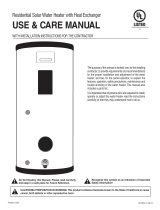 Richmond S120HE-1 User manual
Richmond S120HE-1 User manual
-
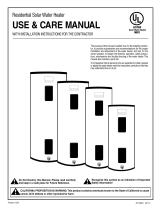 Richmond S80U-1 User manual
Richmond S80U-1 User manual
-
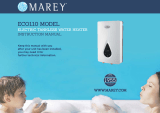 Marey ECO110 User manual
Marey ECO110 User manual
-
Maxwell MS100C2P*U Datasheet
-
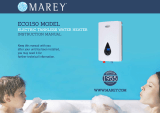 Marey ECO150 User guide
Marey ECO150 User guide
-
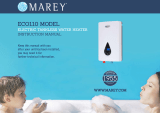 Marey ECO110 User manual
Marey ECO110 User manual
-
Marathon MR40245 User guide
-
Reliance Water Heaters 6 10 SOMS K Owner's manual
-
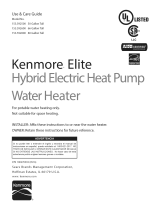 Kenmore Elite 153592600 Owner's manual
Kenmore Elite 153592600 Owner's manual





















